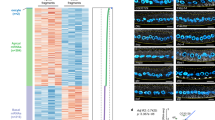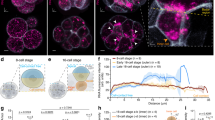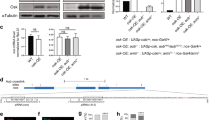Abstract
Localization of cytoplasmic messenger RNA transcripts is widely used to target proteins within cells. For many transcripts, localization depends on cis-acting elements within the transcripts and on microtubule-based motors; however, little is known about other components of the transport machinery or how these components recognize specific RNA cargoes. Here, we show that in Drosophila the same machinery and RNA signals drive specific accumulation of maternal RNAs in the early oocyte and apical transcript localization in blastoderm embryos. We demonstrate in vivo that Egalitarian (Egl) and Bicaudal D (BicD), maternal proteins required for oocyte determination, are selectively recruited by, and co-transported with, localizing transcripts in blastoderm embryos, and that interfering with the activities of Egl and BicD blocks apical localization. We propose that Egl and BicD are core components of a selective dynein motor complex that drives transcript localization in a variety of tissues.
This is a preview of subscription content, access via your institution
Access options
Subscribe to this journal
Receive 51 print issues and online access
$199.00 per year
only $3.90 per issue
Buy this article
- Purchase on Springer Link
- Instant access to full article PDF
Prices may be subject to local taxes which are calculated during checkout




Similar content being viewed by others
References
St Johnston, D. The intracellular localization of messenger RNAs. Cell 81, 161–170 (1995).
Bashirullah, A., Cooperstock, R. L. & Lipshitz, H. D. RNA localization in development. Ann. Rev. Biochem. 67, 335–394 (1998).
Neuman-Silberberg, F. S. & Schüpbach, T. The Drosophila dorsoventral patterning gene gurken produces a dorsally localized RNA and encodes a TGFα-like protein. Cell 75, 165–174 (1993).
Gonzalez-Reyes, A., Elliott, H. & St Johnston, D. Polarization of both major body axes in Drosophila by gurken-torpedo signalling. Nature 375, 654–658 (1995).
Roth, S., Neuman-Silberberg, F. S., Barcelo, G. & Schüpbach, T. cornichon and the EGF receptor signaling process are necessary for both anterior-posterior and dorsal-ventral pattern formation in Drosophila. Cell 81, 967–978 (1995).
Berleth, T. et al. The role of localisation of bicoid RNA in organising the anterior pattern of the Drosophila embryo. EMBO J. 7, 1749–1756 (1988).
Ephrussi, A., Dickinson, L. K. & Lehmann, R. oskar organizes the germ plasm and directs localization of the posterior determinant nanos. Cell 66, 37–50 (1991).
Kim-Ha, J., Smith, J. L. & MacDonald, P. M. oskar messenger-RNA is localized to the posterior pole of the Drosophila oocyte. Cell 66, 23–34 (1991).
Davis, I. & Ish-Horowicz, D. Apical localisation of pair-rule transcripts requires 3′ sequences and limits protein diffusion in the Drosophila blastoderm embryo. Cell 67, 927–940 (1991).
Lall, S., Francis-Lang, H., Norvell, A., Schüpbach, T. & Ish-Horowicz, D. Squid hnRNP protein promotes apical cytoplasmic transport and localisation of Drosophila pair-rule transcripts. Cell 98, 171–180 (1999).
Simmonds, A., DosSantos, G., Livne-Bar, I. & Krause, H. Apical localization of wingless transcripts is required for Wingless signaling. Cell 105, 197–207 (2001).
Wilkie, G. S. & Davis, I. Drosophila wingless and pair-rule transcripts localise apically by dynein mediated transport of RNA particles. Cell 105, 209–219 (2001).
Serano, T. L. & Cohen, R. S. A small predicted stem-loop structure mediates oocyte localization of Drosophila K10 mRNA. Development 121, 3809–3818 (1995).
Saunders, C. & Cohen, R. S. The role of oocyte transcription, the 5′UTR, and translation repression and derepression in Drosophila gurken mRNA and protein localization. Mol. Cell 3, 43–54 (1999).
Macdonald, P. M. & Kerr, K. Redundant RNA recognition events in bicoid mRNA localization. RNA 3, 1413–1420 (1997).
Riedl, A. & Jacobs-Lorena, M. Determinants of Drosophila fushi tarazu mRNA instability. Mol. Cell Biol. 16, 3047–3053 (1996).
Theurkauf, W. E. Microtubules and cytoplasm organization during Drosophila oogenesis. Dev. Biol. 165, 352–360 (1994).
Pokrywka, N. J. & Stephenson, E. C. Microtubules mediate the localization of bicoid RNA during Drosophila oogenesis. Development 113, 55–66 (1991).
Ish-Horowicz, D. & Pinchin, S. M. Pattern abnormalities induced by ectopic expression of the Drosophila gene hairy are associated with repression of fushi tarazu transcription. Cell 51, 405–415 (1987).
Mohler, J. & Wieschaus, E. F. Dominant maternal-effect mutations of Drosophila melanogaster causing the production of double-abdomen embryos. Genetics 112, 803–822 (1986).
Suter, B. & Steward, R. Requirement for phosphorylation and localization of the Bicaudal-D protein in Drosophila oocyte differentiation. Cell 67, 917–926 (1991).
Schüpbach, T. & Wieschaus, E. Female sterile mutations on the second chromosome of Drosophila melanogaster. II. Mutations blocking oogenesis or altering egg morphology. Genetics 129, 1119–1136 (1991).
Theurkauf, W. E., Alberts, B. M., Jan, Y. N. & Jongens, T. A. A central role for microtubules in the differentiation of Drosophila oocytes. Development 118, 1169–1180 (1993).
Mach, J. M. & Lehmann, R. An Egalitarian–BicaudalD complex is essential for oocyte specification and axis determination in Drosophila. Genes Dev. 11, 423–435 (1997).
Ran, B., Bopp, R. & Suter, B. Null alleles reveal novel requirements for Bic-D during Drosophila oogenesis and zygotic development. Development 120, 1233–1242 (1994).
Wharton, R. P. & Struhl, G. Structure of the Drosophila Bicaudal-D protein and its role in localizing the posterior determinant nanos. Cell 59, 881–892 (1989).
Suter, B., Romberg, L. M. & Steward, R. Bicaudal-D, a Drosophila gene involved in developmental asymmetry-localized transcript accumulation in ovaries and sequence similarity to myosin heavy-chain tail domains. Genes Dev. 3, 1957–1968 (1989).
Moser, M. J., Holley, W. R., Chatterjee, A. & Mian, I. S. The proofreading domain of Escherichia coli DNA polymerase I and other DNA and/or RNA exonuclease domains. Nucleic Acids Res. 25, 5110–5118 (1997).
Oh, J. & Steward, R. Bicaudal-D is essential for egg chamber formation and cytoskeletal organization in Drosophila oogenesis. Dev. Biol. 232, 91–104 (2001).
Swan, A. & Suter, B. Role of Bicaudal-D in patterning the Drosophila egg chamber in mid-oogenesis. Development 122, 3577–3586 (1996).
Oh, J., Baksa, K. & Steward, R. Functional domains of the Drosophila Bicaudal-D protein. Genetics 154, 713–724 (2000).
Swan, A., Nguyen, T. & Suter, B. Drosophila Lissencephaly-1 functions with Bic-D and dynein in oocyte determination and nuclear positioning. Nature Cell Biol. 1, 444–449 (1999).
Thio, G. L., Ray, R. P., Barcelo, G. & Schüpbach, T. Localization of gurken RNA in Drosophila oogenesis requires elements in the 5′ and 3′ regions of the transcript. Dev. Biol. 221, 435–446 (2000).
Lantz, V. & Schedl, P. Multiple cis-acting targeting sequences are required for orb mRNA localization during Drosophila oogenesis. Mol. Cell Biol. 14, 2235–2242 (1994).
Schnorrer, F., Bohmann, K. & Nusslein-Volhard, C. The molecular motor dynein is involved in targeting Swallow and bicoid RNA to the anterior pole of Drosophila oocytes. Nature Cell Biol. 2, 185–190 (2000).
Macdonald, P. M., Luk, S. K. & Kilpatrick, M. Protein encoded by the exuperantia gene is concentrated at sites of bicoid mRNA accumulation in Drosophila nurse cells but not in oocytes or embryos. Genes Dev. 5, 2455–2466 (1991).
Marcey, D., Watkins, W. S. & Hazelrigg, T. The temporal and spatial distribution pattern of maternal Exuperantia protein: evidence for a role in establishment but not maintenance of bicoid mRNA localization. EMBO J. 10, 4259–4266 (1991).
St Johnston, D., Driever, W., Berleth, T., Richstein, S. & Nüsslein-Volhard, C. Multiple steps in the localization of bicoid RNA to the anterior pole of the Drosophila oocyte. Development (Suppl.) 107, 13–19 (1989).
Li, P., Yang, X., Wasser, M., Cai, Y. & Chia, W. Inscuteable and Staufen mediate asymmetric localization and segregation of prospero RNA during Drosophila neuroblast cell divisions. Cell 90, 437–447 (1997).
Karlin-Mcginness, M., Serano, T. L. & Cohen, R. S. Comparative analysis of the kinetics and dynamics of K10, bicoid, and oskar mRNA localization in the Drosophila oocyte. Dev. Genet. 19, 238–248 (1996).
Baens, M. & Marynen, P. A human homologue (BICD1) of the Drosophila Bicaudal-D gene. Genomics 45, 601–606 (1997).
Lantz, V., Chang, J. S., Horabin, J. I., Bopp, D. & Schedl, P. The Drosophila orb RNA-binding protein is required for the formation of the egg chamber and establishment of polarity. Genes Dev. 8, 598–613 (1994).
St Johnston, D., Beuchle, D. & Nüsslein-Volhard, C. staufen, a gene required to localize maternal RNAs in the Drosophila egg. Cell 66, 51–63 (1991).
Sharp, D. J. et al. Functional coordination of three mitotic motors in Drosophila embryos. Mol. Biol. Cell 11, 241–253 (2000).
Tautz, D. & Pfeifle, C. A non-radioactive in situ hybridization method for the localization of specific RNAs in Drosophila embryos reveals translational control of the segmentation gene hunchback. Chromosoma 98, 81–85 (1989).
Acknowledgements
We are grateful to I. Davis, N. MacDougall, G. Wilkie, D. Baker, A. Flament and J. Hughes for discussions; R. Lehmann, R. Steward, D. Sharp, B. Suter, M. Jacobs-Lorena, D. St Johnston, G. Dollar, L. Gavis, B. Cohen and Developmental Studies Hybridoma Bank for providing reagents; and many colleagues for comments on the manuscript. This work was supported by the Imperial Cancer Research Fund and a fellowship from the Royal Commission for the Exhibition of 1851 (to S.L.B.).
Author information
Authors and Affiliations
Corresponding author
Rights and permissions
About this article
Cite this article
Bullock, S., Ish-Horowicz, D. Conserved signals and machinery for RNA transport in Drosophila oogenesis and embryogenesis. Nature 414, 611–616 (2001). https://doi.org/10.1038/414611a
Received:
Accepted:
Issue Date:
DOI: https://doi.org/10.1038/414611a
This article is cited by
-
Dynamics of maternal gene expression in Rhodnius prolixus
Scientific Reports (2022)
-
Subcellular spatial transcriptomics identifies three mechanistically different classes of localizing RNAs
Nature Communications (2022)
-
Walking the line: mechanisms underlying directional mRNA transport and localisation in neurons and beyond
Cellular and Molecular Life Sciences (2021)
-
Dynein activating adaptor BICD2 controls radial migration of upper-layer cortical neurons in vivo
Acta Neuropathologica Communications (2019)
-
A role for Bicaudal-D2 in radial cerebellar granule cell migration
Nature Communications (2014)
Comments
By submitting a comment you agree to abide by our Terms and Community Guidelines. If you find something abusive or that does not comply with our terms or guidelines please flag it as inappropriate.



